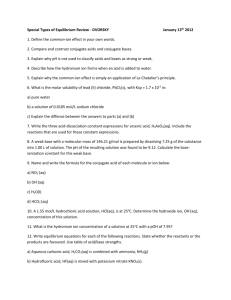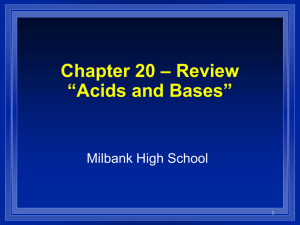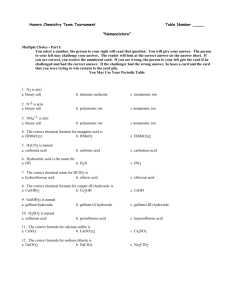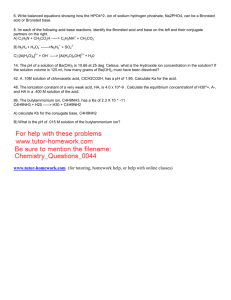Problem Set 12 with solutions
advertisement
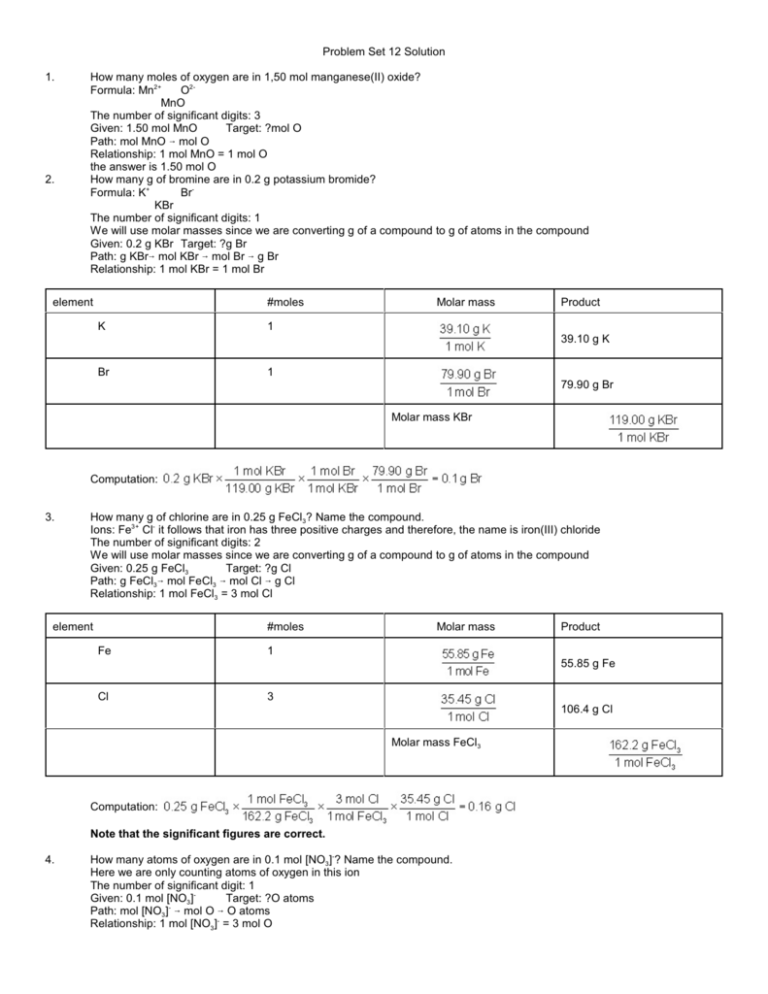
Problem Set 12 Solution 1. 2. How many moles of oxygen are in 1,50 mol manganese(II) oxide? Formula: Mn2+ O2MnO The number of significant digits: 3 Given: 1.50 mol MnO Target: ?mol O Path: mol MnO 6 mol O Relationship: 1 mol MnO = 1 mol O the answer is 1.50 mol O How many g of bromine are in 0.2 g potassium bromide? Formula: K+ BrKBr The number of significant digits: 1 We will use molar masses since we are converting g of a compound to g of atoms in the compound Given: 0.2 g KBr Target: ?g Br Path: g KBr6 mol KBr 6 mol Br 6 g Br Relationship: 1 mol KBr = 1 mol Br element #moles K Molar mass Product 1 39.10 g K Br 1 79.90 g Br Molar mass KBr Computation: 3. How many g of chlorine are in 0.25 g FeCl3? Name the compound. Ions: Fe3+ Cl- it follows that iron has three positive charges and therefore, the name is iron(III) chloride The number of significant digits: 2 We will use molar masses since we are converting g of a compound to g of atoms in the compound Given: 0.25 g FeCl3 Target: ?g Cl Path: g FeCl36 mol FeCl3 6 mol Cl 6 g Cl Relationship: 1 mol FeCl3 = 3 mol Cl element #moles Fe Molar mass Product 1 55.85 g Fe Cl 3 106.4 g Cl Molar mass FeCl3 Computation: Note that the significant figures are correct. 4. How many atoms of oxygen are in 0.1 mol [NO3]-? Name the compound. Here we are only counting atoms of oxygen in this ion The number of significant digit: 1 Given: 0.1 mol [NO3]Target: ?O atoms Path: mol [NO3 ]- 6 mol O 6 O atoms Relationship: 1 mol [NO3]- = 3 mol O Computation: 5. Note that the significant figures are correct. Draw Lewis diagrams of these oxyanions: bromate ion (bromine is less electronegative than oxygen); sulfite ion; phosphite ion; nitrate ion; carbonate ion. When drawing Lewis diagram of oxyanions follow the procedure that you have learned in class. a. bromate ion [BrO3]- has one negative charge n = 4 x 8 = 32 v = 7 + 3 x 6 + 1 = 26 s=6 b=3 lp = (32 - 2 x 6)/2 = 10 b. sulfite ion [SO3]2- has two negative charges n = 4 x 8 = 32 v = 6 + 3 x 6 + 2 = 26 s=6 b=3 lp = (32 - 2 x 6)/2 = 10 c. phosphite [PO3]3- has three negative charges n = 4 x 8 = 32 v = 5 + 3 x 6 + 3 = 26 s=6 b=3 lp = (32 - 2 x 6)/2 = 10 d. nitrate ion [NO3 ]- has one negative charge n = 4 x 8 = 32 v = 5 + 3 x 6 + 1 = 24 s=8 b=4 lp = (32 - 2 x 8)/2 = 8 Note that this is one of the possible arrangements of four bonds - it does not matter at this stage which one of them you draw. e. carbonate ion [CO3]2- has two negative charges n = 4 x 8 = 32 v = 4 + 3 x 6 + 2 = 24 s=8 b=4 lp = (32 - 2 x 8)/2 = 8 Note that this is one of the possible arrangements of four bonds - it does not matter at this stage which one of them you draw. 6. Write a symbol for each of the following elements, ions, isotopes or compounds that exist in nature: a. b. c. d. e. f. g. 7. beryllium-8 iodine dicarbon hexachloride calcium nitride phosphide ion cobalt(II) phosphide dinitrogen trioxide Write the name for each of the following elements, ions, isotopes or compounds that exist in nature: a. H2 hydrogen b. 8. I2 C2Cl6 Ca3N2 P3+ Co3P2 N2O3 nitrogen-15 - c. d. e. F Cl2 O MnS f. Cu3N g. CaI2 fluoride ion dichlorine oxide manganese(II) sulfide since sulfide ion S2- has two negative charges then the manganese must also have two positive charges and therefore manganese(II) copper(I) nitride since nitride ion N3- has three positive charges then the copper must only one positive charge and therefore copper(I) calcium iodide Fill in the table - see an attempt at explanation in square brackets [formula begins with H implies acid]; formula ends with [....OH] implies a base. Further, -ate ion implies an -ic acid; -ite implies an -ous acid and an absence of oxygen implies a hydro..ic acid: formula acid or base name the two ions write formulas for ions name the compound H2 CO3 acid [H...] hydrogen ion; carbonate ion [! -ic acid] H+ (CO3)2- carbonic acid Be(OH)2 base [...OH] beryllium ion; hydroxide ion Be2+ (OH)- beryllium hydroxide LiOH base [....OH] lithium ion; hydroxide ion Li+ (OH)- lithium hydroxide HClO2 acid [H....] hydrogen ion; chlorite ion [! -ous acid] H+ (ClO2 )- chlorous acid H3 PO3 acid [H....] hydrogen ion; phosphite ion [! -ous acid] H+ (PO3 )3- phophorous acid Cu(OH)2 base [....OH] copper(II) ion; hydroxide ion Cu2+ (OH)- copper(II) hydroxide Fe(OH)3 base [....OH] iron(III) ion; hydroxide ion Fe3+ (OH)- iron(III) hydroxide HI acid [H....] hydrogen ion; fluoride ion [no oxygen ! hydro...ic acid] H+ H2 SO4 acid [H....] hydrogen ion; sulfate ion [! -ic acid] H+ F- (SO4)2- hydroiodic acid sulfuric acid 9. Fill in the table: name of the compound acid or base name the two ions write formula of the two ions write the formula of the compound hydrosulfuric acid acid hydrogen ion; sulfide ion H+ S2- H2 S iodous acid acid hydrogen ion; iodite ion H+ (IO2)- HIO2 potassium hydroxide base [...hydroxide in the name] potassium ion; hydroxide ion K+ (OH)- KOH cobalt(III) hydroxide base [...hydroxide in the name] cobalt(III) ion; hydroxide ion Co3+ (OH)- Co(OH)3 phosphoric acid acid hydrogen ion; phosphate ion H+ (PO3)3- H3PO3 chloric acid acid hydrogen ion; chlorate ion H+ (ClO3)- H ClO3 copper(I) hydroxide base [...hydroxide in the name] copper(I) ion; hydroxide ion Cu+ (OH)- CuOH nitrous acid acid hydrogen ion; nitrite ion H+ (NO2 )- H NO2 iron(II) hydroxide base [...hydroxide in the name] iron(II) ion; hydroxide ion Fe2+ (OH)- Fe(OH)3


